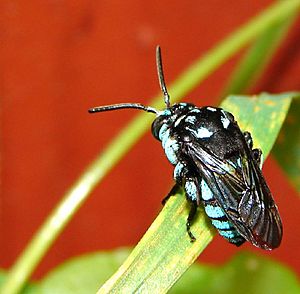Neon cuckoo bee facts for kids
Quick facts for kids Thyreus nitidulus |
|
|---|---|
 |
|
| Scientific classification |
The Thyreus nitidulus, also known as the neon cuckoo bee, is a very special type of bee. It gets its name "cuckoo bee" because it lays its eggs in the nests of other bees, much like cuckoo birds do. This bee is quite chunky and stands out with its amazing bright blue and black stripes.
Contents
What is the Neon Cuckoo Bee?
The neon cuckoo bee is a member of the Thyreus group of bees. These bees are known for their unique way of life. They don't build their own nests or collect pollen to feed their young. Instead, they rely on other bees to do that work for them.
A Little History of Its Name
A Danish scientist named Johan Christian Fabricius first described this bee in 1804. He found it in places like the Aru Islands or northern Australia. He first called it Melecta nitidula. Later, in 1959, another scientist, M. A. Lieftinck, gave it its current scientific name, Thyreus nitidulus. The word nitidulus comes from a Latin word meaning "shining" or "little shiny one," which perfectly describes this bee's bright look!
Where Do They Live?
You can find the main type of neon cuckoo bee, called T. n. nitidulus, across eastern and northern Australia. This includes places like New South Wales, Queensland, South Australia, and the Northern Territory. They also live in New Guinea. Other types of these bees can be found in Southeast Asia.
What Does a Neon Cuckoo Bee Look Like?
Like all bees, the neon cuckoo bee is covered in soft, branched hairs. These hairs are what give the bee its amazing black and blue colors.
Colors and Body
- Head: Much of its face is covered in pale blue hairs.
- Body: It has patches of blue hair on the sides of its middle section (called the thorax) and on its legs.
- Abdomen: The back part of its body (the abdomen) has bright blue and black stripes.
- Wings: Its clear wings have a hint of purple-brown color.
- Build: This bee is quite strong and sturdy, especially its thorax, which is extra tough.
Life Cycle and Reproduction
The neon cuckoo bee has a very interesting way of reproducing. It's known as a "cuckoo bee" because it doesn't raise its own young.
How They Reproduce
The female neon cuckoo bee looks for the underground nests of another bee, the blue-banded bee (Amegilla cingulata). When a blue-banded bee leaves its nest for a moment, the female cuckoo bee quickly sneaks in. She lays one of her eggs inside a special cell that the blue-banded bee is still building for its own young.
What Happens Next?
Once the cuckoo bee's egg hatches, the young cuckoo bee larva grows. It then eats the food that the blue-banded bee had stored for its own baby. After it has eaten enough, the cuckoo bee larva grows and eventually emerges from the cell as an adult bee. This way, the neon cuckoo bee's young are cared for by another bee species.

